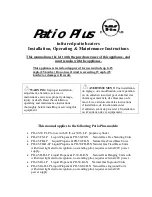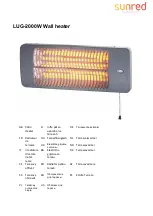
Mighty Therm Volume Water Heater
Page 9
Special attention must be given to relief valve
settings in installations where the heater is
located on the ground floor of a tall building.
The static pressure of the system is elevated and
could cause the relief valve to leak. Where no
special setting of the relief valve is ordered, the
factory will furnish a 125 psi setting. Never
reduce the relief valve openings.
3.
Pressure relief valve lever must be tripped at
least once a year to insure that waterways are
clean. When manually operating lever, water will
discharge through drain line. Precautions must be
taken to avoid contact with hot water and water
damage.
4.
The weight of all water and gas piping should be
supported by suitable hangers or floor stands.
5.
Check piping diagrams with local applicable
plumbing, heating and building safety codes.
6.
All two-temperature systems using temperature
valves must have forced recirculation in the low
temperature building loop.
7.
A check valve installed at the hot water inlet to
the tempering valve will prevent cold water from
being drawn in reverse through the tempering
valve into the hot water.
8.
When installing a tempering valve, place at
bottom of antithermosyphon loop at least 24"
high to prevent excessive hot water from
entering mixed water supply. Bring the cold
water supply up from the floor to the valve (see
Figure 10).
2G. Water Expansion
When cold water is heated the water expands. If
no water is being used during the heat-up period the
expanded water will normally back up into the city
mains.
A water pressure reducing valve installed in the
incoming cold water line may act as a check valve and
prevent the expanded water from moving backward.
This will cause pressure to rise in the heater, which
will be relieved by the pressure relief valve.
If the relief valve pops frequently a mineral
deposit may build up on the valve seat, causing it to
leak.
The following suggestions may solve the problem:
1.
Install a properly sized expansion tank.
2.
Replace the installed water pressure reducing valve
with a suitable valve having a back flow port. These
valves have a back flow port which allows water
to flow backwards when the pressure in the system
exceeds the pressure in the mains.
3.
Install a check valve around the pressure reducing
valve to permit reverse flow. This will allow
the expanded water to back flow into the mains.
4.
Install an auxiliary small relief valve set at 25 psi
less than the main relief valve. The valve must be
piped to a drain and may require occasional
cleaning. It will bleed off the expanded water
and protect the main pressure relief valve from
becoming fouled.
Figure 9. Pressure Relief Valve Location.
Figure 10. Tempering Valve Installation.










































